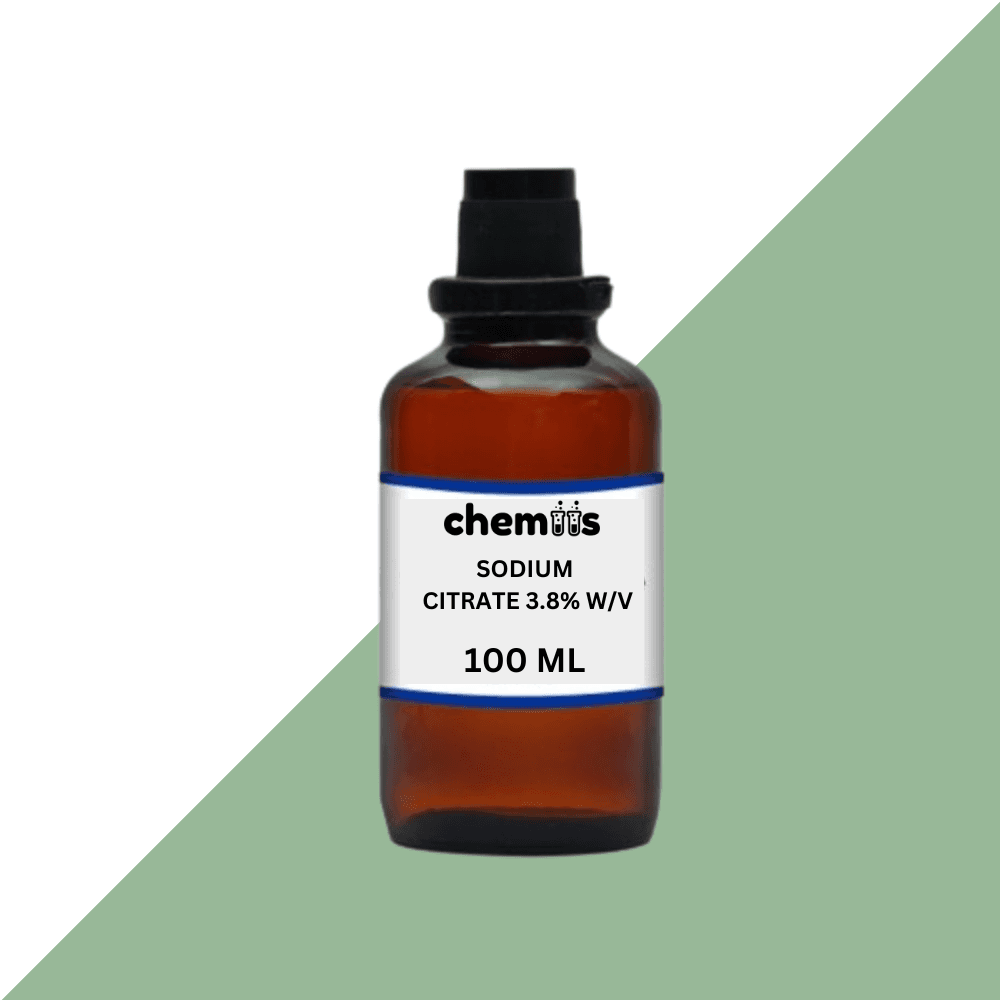Sodium Citrate 3.8% W/V is an aqueous solution containing 3.8% by weight of Sodium Citrate (Na₃C₆H₅O₇), a salt of citric acid. It is a clear, colorless, or slightly yellowish solution that is widely used in medical, pharmaceutical, food, and industrial applications. Due to its ability to regulate pH levels, act as an anticoagulant, and preserve the stability of various products, Sodium Citrate 3.8% W/V is a versatile compound. It is commonly used in rehydration solutions, blood collection tubes, and as a stabilizer in different solutions and formulations.
Applications
1. Medical and Pharmaceutical Applications
- Anticoagulant: Sodium Citrate 3.8% W/V is widely used as an anticoagulant in blood collection tubes and during blood transfusions to prevent clotting by chelating calcium ions. It is frequently used in laboratories for the collection and preservation of blood samples, especially in diagnostic testing.
- Rehydration Solutions: This solution is commonly found in oral rehydration salts (ORS) and intravenous fluids, where it helps maintain electrolyte balance and prevents dehydration. Sodium Citrate 3.8% W/V helps in maintaining the appropriate pH in these solutions, enhancing their effectiveness in treating dehydration.
- Urinary Alkalinization: Sodium Citrate 3.8% W/V is used in medical treatments to alkalinize urine. It is prescribed for conditions like urinary tract infections (UTIs) and kidney stones, helping to increase the solubility of uric acid and prevent the formation of kidney stones.
2. Food and Beverage Industry
- pH Regulator and Buffering Agent: Sodium Citrate is used in food and beverages to maintain the desired pH level, especially in dairy products, soft drinks, and fruit juices. It helps preserve flavor and ensures product stability.
- Emulsifier: In processed cheese production, Sodium Citrate acts as an emulsifying agent to prevent oil separation and improve texture and consistency.
- Preservative: As a mild preservative, Sodium Citrate extends the shelf life of various beverages and processed foods by inhibiting microbial growth.
3. Laboratory and Analytical Chemistry
- Buffering Solutions: Sodium Citrate 3.8% W/V is employed in laboratory experiments as part of buffer solutions for maintaining the pH stability of samples in biochemical and molecular biology research.
- Chelating Agent: In chemical analysis, Sodium Citrate is used as a chelating agent to bind metal ions, particularly in titrations and other analytical tests where metal ion interference needs to be minimized.
- Stabilizing Agent: Sodium Citrate stabilizes certain reagents, preventing the precipitation of salts and the degradation of chemicals during analysis or reactions.
4. Industrial and Other Uses
- Cleaning and Detergent Formulations: Sodium Citrate 3.8% W/V can be found in industrial cleaning solutions where it acts as a chelating agent, preventing scale formation in pipes and machinery. It helps remove hard water deposits and other mineral buildups.
- Cosmetics and Personal Care Products: Sodium Citrate is used in personal care products like shampoos, lotions, and facial cleansers as a pH regulator, ensuring the formulation remains safe for skin application.
Safety and Handling
Hazards:
- Non-toxic: Sodium Citrate 3.8% W/V is generally recognized as safe (GRAS) for use in food and medical applications. However, direct contact with high concentrations or large amounts may cause mild irritation to the eyes and skin.
- Inhalation: No significant hazards associated with inhalation under normal handling conditions, though inhaling high dust concentrations may cause respiratory irritation.
- Ingestion: If swallowed in large quantities, Sodium Citrate may cause gastrointestinal irritation. In general, this product is considered safe for consumption in regulated amounts.
Precautions:
- Personal Protective Equipment (PPE):
- Wear protective gloves, safety goggles, and lab coats when handling the solution in bulk to avoid contact with skin and eyes.
- In environments where Sodium Citrate is used in powdered form or aerosolized, use a dust mask to avoid inhalation.
- Handling Guidelines:
- Ensure that the solution is handled in a well-ventilated area, especially when working with large quantities.
- Always follow the product’s Material Safety Data Sheet (MSDS) or safety data sheet for detailed handling guidelines.
Storage:
- Temperature: Store Sodium Citrate 3.8% W/V in a cool, dry place, away from extreme temperatures and direct sunlight.
- Container: Keep the solution in tightly sealed containers to prevent contamination and evaporation.
- Shelf Life: Check product expiration dates before use. Generally, Sodium Citrate solutions should be used within a few months of opening to ensure efficacy and safety.
First Aid Measures:
- Inhalation: Move the individual to fresh air. If symptoms persist, seek medical attention.
- Skin Contact: Wash with soap and water for at least 15 minutes. If irritation persists, seek medical advice.
- Eye Contact: Rinse immediately with plenty of water for at least 15 minutes. If irritation continues, consult a healthcare provider.
- Ingestion: Rinse mouth with water and drink plenty of fluids. If symptoms occur or a large quantity is ingested, seek immediate medical attention.
Disposal:
- Dispose of Sodium Citrate 3.8% W/V according to local environmental regulations. It is generally safe for disposal in household waste but should not be released into water systems without proper treatment.


















Reviews
Clear filtersThere are no reviews yet.